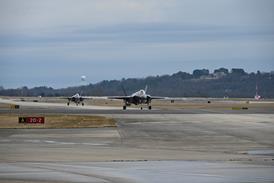Ironically, at a time of unprecedented recent commercial and military interest in new high-speed aircraft, NASA's supersonic researchers faces much the same funding crisis as their hypersonic brethren. "Budgets are tight, and priorities need to be established," says Robert Shaw, associate director for partnership programmes at NASA Glenn Research Center.
To counter the critical funding shortfall, the agency is evaluating much closer co-operative ties with other government branches, the Department of Defense, Federal Aviation Administration and industry to try and pool research funds and resources, as well as harmonise targets. "It is becoming even more crucial as funding shrinks that duplication and overlap has to be by design and not accident," says Shaw.
Taking its cue from the successful US Defense Advanced Research Projects Agency-led Quiet Supersonic Platform (QSP) effort, one such initiative is called "Super 10". With the goal of bringing quiet - or boomless - supersonic capability to maturity in 10 years, the study is a joint NASA and industry effort to "look at what it will take to get the low [sonic] boom beyond where the QSP left off," says Shaw. The Super 10 plan will be presented to NASA management, he adds.
Judging by the plans unveiled at this year's National Business Aircraft Association show there will be several potential applications for the technology. All told, there are believed to be up to nine aircraft makers studying possible supersonic business jet designs ranging in size from four- to six-seaters, all the way to 12-seaters with stretch potential. Virtually all are aimed at the Mach 1.4-1.8 cruise speed range, avoiding the requirement for the more exotic airframe materials needed for temperatures encountered at the higher Mach numbers as well as lowering the engine inlet temperature and simplifying the inlet.
At least one project, led by Reno, Nevada-based Aerion, expects to be able to meet the performance targets with a highly adapted, derated version of the Pratt & Whitney JT8D-219, but most expect more advanced, fully integrated propulsion system designs that are derived from military-developed variable-cycle turbofan technology, but with Stage 4-plus capable inlet and exhaust features.
Source: Flight International























